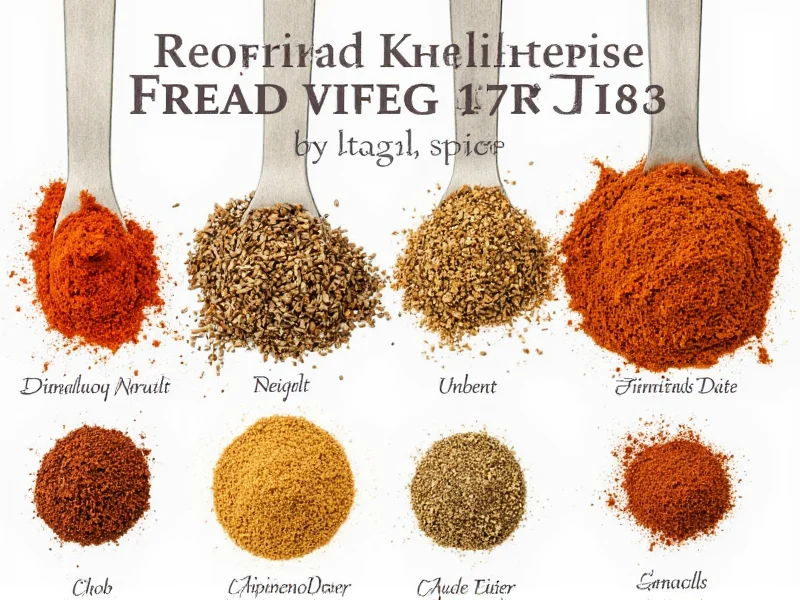Understanding Spice Expiration Dates and Shelf Life
When you find spices in your pantry past their labeled date, your first concern should be flavor quality rather than safety. Unlike perishable foods, dried spices don't spoil in ways that make them dangerous to consume. The dates printed on spice containers primarily indicate when the manufacturer guarantees peak flavor quality.
What 'Expiration Date' Really Means for Spices
The term 'expiration date' is somewhat misleading for dried spices. Most spice manufacturers use 'best by' or 'use by' dates that reflect optimal flavor rather than safety concerns. These dates typically range from 2-4 years from packaging. After this date, spices gradually lose their essential oils and volatile compounds that provide flavor and aroma, but they don't become unsafe unless contaminated.
Spice Shelf Life: Whole vs. Ground
The physical form of your spices dramatically affects how long they remain usable after the expiration date. Whole spices like peppercorns, cinnamon sticks, and cloves retain their potency much longer than their ground counterparts because they have less surface area exposed to degrading elements.
| Spice Type | Typical Shelf Life After Expiration | Signs of Degradation |
|---|---|---|
| Whole spices (peppercorns, cinnamon sticks) | 3-4 years | Faded color, weak aroma when crushed |
| Ground spices (cumin, paprika) | 2-3 years | Dull color, musty smell, little flavor impact |
| Herbs (dried basil, oregano) | 1-2 years | Brownish color, crumbly texture, no aroma |
| Spice blends (curry powder, chili powder) | 1-2 years | Separated ingredients, stale smell |
Factors That Extend Spice Usability Beyond Expiration Dates
Several environmental factors determine how long you can keep spices after their expiration date while maintaining acceptable quality:
- Container quality: Airtight glass or metal containers preserve potency significantly longer than plastic bags or original cardboard tubes
- Storage location: Cool, dark places away from heat sources (like stoves or windows) prevent rapid flavor degradation
- Moisture control: Keeping spices dry prevents clumping and mold growth, especially important for salt-containing blends
- Handling practices: Using dry utensils prevents introducing moisture that accelerates spoilage
How to Test if Your Expired Spices Are Still Good
Before discarding spices past their date, perform these simple tests to determine their usability:
- The smell test: Crush a small amount in your palm and smell it. Potent spices should produce a strong, distinctive aroma. If you barely detect any scent, the spice has lost most of its flavor compounds.
- The color check: Compare the color to a newer spice if available. Faded or dull colors indicate significant flavor loss, especially noticeable in paprika and turmeric.
- The taste test: For ground spices, mix a tiny amount with a neutral food like plain rice or yogurt. If the flavor barely registers or tastes musty, it's time to replace the spice.
- The texture assessment: Check for clumping or moisture. While some clumping is normal in humid environments, hard clumps or visible mold mean the spice should be discarded.
Proper Storage Techniques for Maximizing Spice Longevity
Implement these storage methods to extend how long you can keep spices after expiration date while maintaining quality:
Transfer spices from flimsy packaging to airtight containers immediately after purchase. Dark glass jars with tight-sealing lids work best, though quality metal tins also provide excellent protection. Store your spice collection in a cool, dark cabinet away from your stove, dishwasher, or any heat source. The ideal storage temperature is below 70°F (21°C) with low humidity.
Avoid storing spices above your stove—a common but problematic location—as the repeated heat exposure dramatically accelerates flavor loss. If you buy spices in bulk, consider dividing them into two containers: a small everyday container for regular use and a larger airtight container stored in the refrigerator or freezer for long-term preservation.
When to Definitely Discard Expired Spices
While most dried spices remain safe indefinitely, certain conditions require immediate disposal:
- Visible mold growth of any kind
- Signs of insect infestation (webs, larvae, or actual insects)
- Musty or sour odors instead of characteristic spice aromas
- Moisture or clumping that doesn't break apart easily
- Spice blends containing salt that have become rock-hard
Remember that while consuming degraded spices won't make you sick, they provide minimal flavor benefit and may negatively affect your dishes. Using extremely old spices essentially means you're adding bulk without flavor, which can throw off recipe balances.
Practical Uses for Older Spices Past Their Prime
If your spices have lost significant potency but show no signs of spoilage, consider these alternative uses before discarding them:
- Create homemade potpourri by combining faded spices with dried citrus peels and herbs
- Make natural cleaning solutions—older cinnamon, cloves, and citrus spices work well
- Use in gardening as natural pest deterrents (cayenne pepper deters squirrels)
- Combine multiple faded spices to create custom fire starters
- Use in craft projects like homemade playdough or scented candles
Cost-Effective Spice Management Practices
Understanding how long you can keep spices after expiration date helps reduce unnecessary food waste and saves money. Purchase whole spices whenever possible and grind them as needed using a dedicated coffee grinder. Buy smaller quantities of expensive spices like saffron or vanilla beans, and consider joining a spice co-op for hard-to-find varieties. Keep a simple log of purchase dates to track your inventory without relying solely on manufacturer dates.











 浙公网安备
33010002000092号
浙公网安备
33010002000092号 浙B2-20120091-4
浙B2-20120091-4